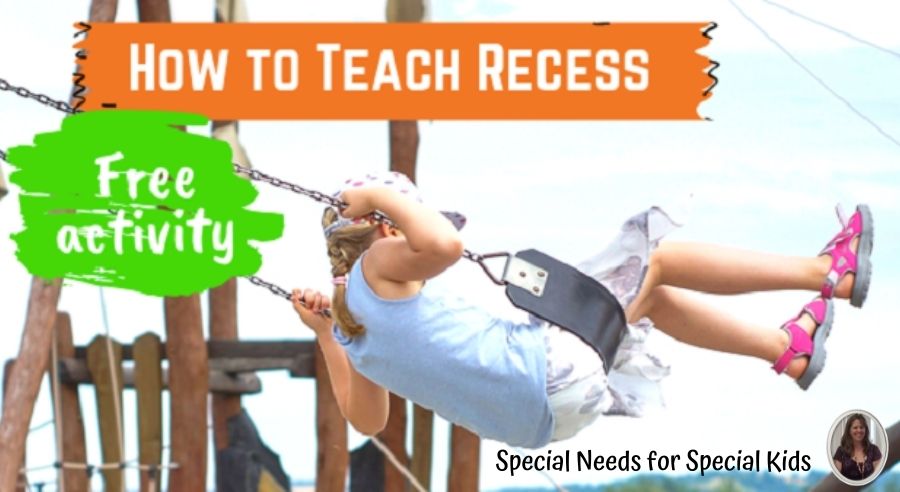Using a social story for recess can be a great tool to help students learn the rules and social expectations when it comes to the playground.
Recess can be stressful
In elementary school, recess is an important and critical part of the day. Students can move around, fill their sensory “buckets” and reset for the remainder of the day. But, for some students recess can be a very stressful time. Perhaps there is the issue of social anxiety, and not knowing how to read their peers’ cues. Or maybe, a student feels isolated and alone as he or she sits and watches other students play all around them. Then there is the whole issue of the equipment. How do you use it? What are the rules? And why can’t I hang upside down when it makes me feel so good?
How to teach social skills needed for recess
These are all common issues many special education teachers face and are aware of. However, few are really sure how to approach helping their students make the most of their recess time. Not every situation is the same, but here are some things that really helped me when I was in an elementary setting when it came to dealing with issues surrounding recess.
Be sure to scroll down to get a free Venn Diagram that will help you teach rules and procedures when it comes to safety on the playground.
1. Be intentional
When it comes to helping your students make the most of their time on the playground, we need to be very intentional with our approach. What does that mean? First, it means we need to have a good understanding of where our students are and what they are going to need help with. That means doing lots of observing. It also is helpful to talk with previous teachers to get a better picture of what was happening last year. Here are some questions to ask:
- Did the student participate in recess with their peers in regular education classrooms, or did he/she have recess just with their special education class?
- Were they with other students who were the same age, or did they go at a time when there were younger/older students on the playground?
- Are there any physical limitations or challenges you need to be aware of? Talking with your occupational and physical therapists can be super helpful here.
- What does he/she enjoy most about the playground? Parents can be very helpful with this as well. Do they take their child to the playground after school hours? What do they find is most enjoyable?
- Does the student understand safety concerns when it comes to the space and equipment? Are they a runner?
- Does the student prefer to play alone or with others?
- Is there special equipment, toys, or activities you can take with you to make it more enjoyable?
- Does the student use a communication device, and if so does it go on the playground with them?
None of these questions should come with any judgement at all. It is simply information gathering. I would never want another teacher or parent to feel like maybe they were doing something wrong. I just want to get a clear picture of the starting point.
So once you have this baseline information (and there are so many more questions you could and should ask), you can start making a plan that is very intentional. It can address certain areas you feel need focus, while building on and utilizing those strengths your student already has. Let’s look at how we can do that.
2. Practice, practice, practice
I found that many of my new students had no idea HOW to use the equipment, so they often never tried. Instead, they would sift wood chips through their fingers or spin an empty swing around for the entire time we were out there. Too often, I would hear remarks like, “This is their time. Just let Joey do what he wants.” And, I am all for giving students plenty of freedom when it comes to recess, but sometimes Joey is spinning a swing because he has no idea what he is supposed to do.
Reading visual cues from other students is often a skill our students lack. Just because 20 other students are in line to go down the big slide, does not mean our students will necessarily notice that and join the line. And what is the best and least intrusive way to help them? You do not necessarily want to be going up to Joey with a picture schedule of what to do at recess. So what are we supposed to do???
Practice!! I would set up certain times throughout the day where just my class would go out to an empty playground and practice what we are “supposed to do” at recess. Because this was a teaching time, I made it clear that we would be following some rules and preparing our bodies to have the most fun possible at recess. I did NOT call this time recess. Depending on the age and language level of your students, you could call it: playground practice, strength training, even follow the leader.
The important thing with this practice is that we want to create some muscle memory. That means we need to do things in a very specific way that is repeated time and time again. After a while, students will be more comfortable with a typical recess routine because it will just feel natural to their bodies.
3. Add some visual and physical cues
I have a blog post all about how to set up a structured walk. Read more about structured walks by visiting my blog post.
In summary, the idea is to take something that is often abstract when it comes to duration and expectations and add some visual structure to make it clear: 1. how long this will last, 2. what I will be doing, and 3. what will happen next. We can do this with recess as well.
This is also where all that practice time comes into play. I would not do this while other students are on the playground. This is done with a small group (preferably just your class) and follows a precise pattern of activities.
Look at the layout of your playground. Almost every playground I have ever been to has pieces of equipment that is super popular with the kids, and some that is rarely used. Focus on those popular pieces. We are wanting our students to engage with their peers on a more natural level, and that will not happen if our kids are on the balance beam all by themselves, and the rest of the kids are spinning on the merry-go-round.
Once you have identified those few (3-5 at most) popular pieces of equipment then gather some beanbags or other object that are easy to see and carry. Place a bean bag at each location. Students then go from one piece of equipment to the other retrieving a bean bag. To make this even more effective, I would use several at some locations. For example, I had a bean bag at the bottom of the stairs going up the slide. Then, I placed one on the top of the slide, peeking out so kids could see if from the ground. Finally, I would put one at the bottom of the slide. You can even number these if your students are able to utilize that skill. Students would gather all 3 bean bags as they went up the ladder and then down the slide. I am not going to lie, this took a lot of patience and a lot of practice, but once students understood the goal, it was worth it. I could begin removing some of the bean bags, and students would still use the piece of equipment as designed.
Here are the key things to remember:
- Always use the same objects
- Always go in the same order
- Have a designated place, person or container to place the bean bags
- Keep it short and focused
- Do not do this with other peers on the playground
4. Using a social story for recess
Most playgrounds seem to have a list of rules that kids and adults are supposed to follow, and it is posted somewhere (not always obvious) on the playground. However, I am willing to bet only first-time moms ever see it or bother to read it. That means we need to take some time in our instructional planning to address the rules and procedures on the playground. Of course, a social story fore recess is my favorite way to do this along with some practice activities.
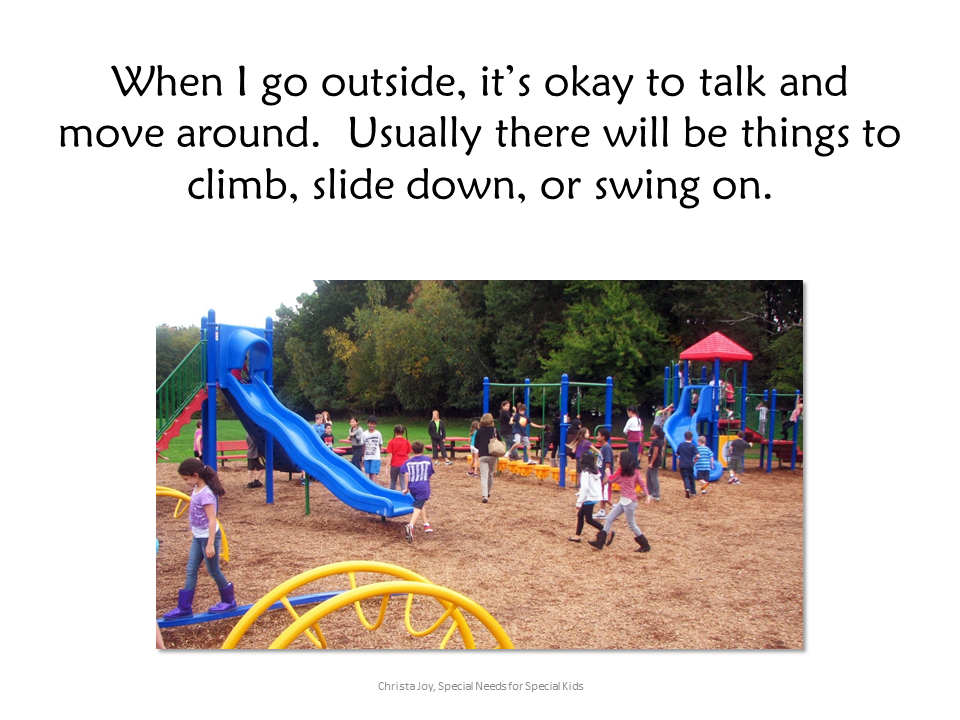
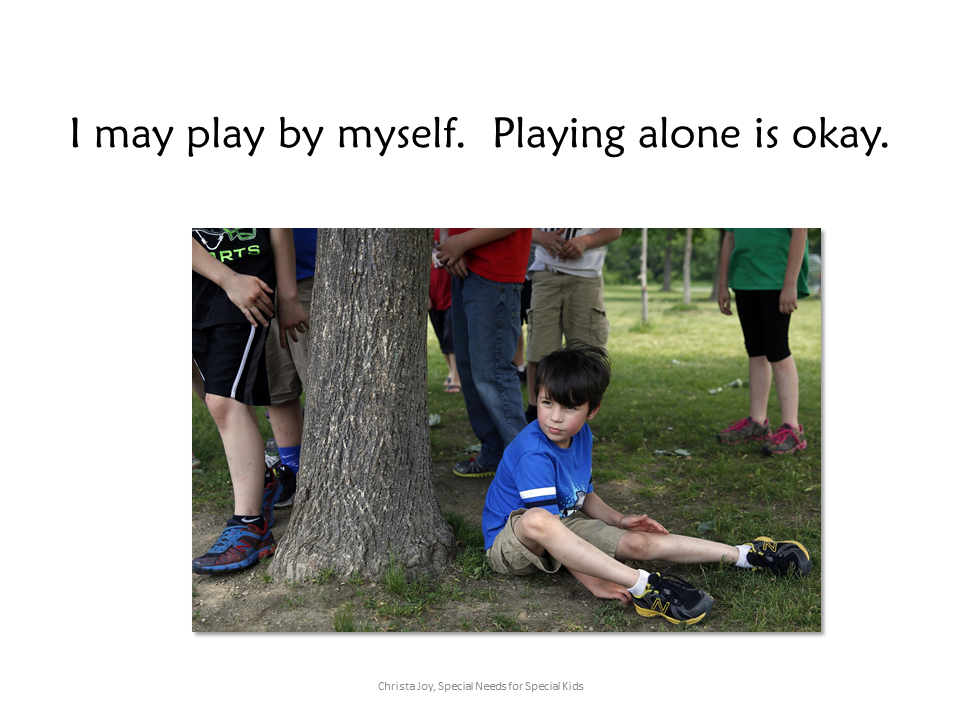
When putting together your social story for recess, I find photos really help students visualize what we are talking about. Of course adding in your own photos using your playground and your students is even better if you have the time and capability.
I think repeating the information in as many formats as possible can be incredibly helpful with generalization. That is why I like to put the same information into a black and white social story for recess booklet using picture symbols that the students can color and personalize.
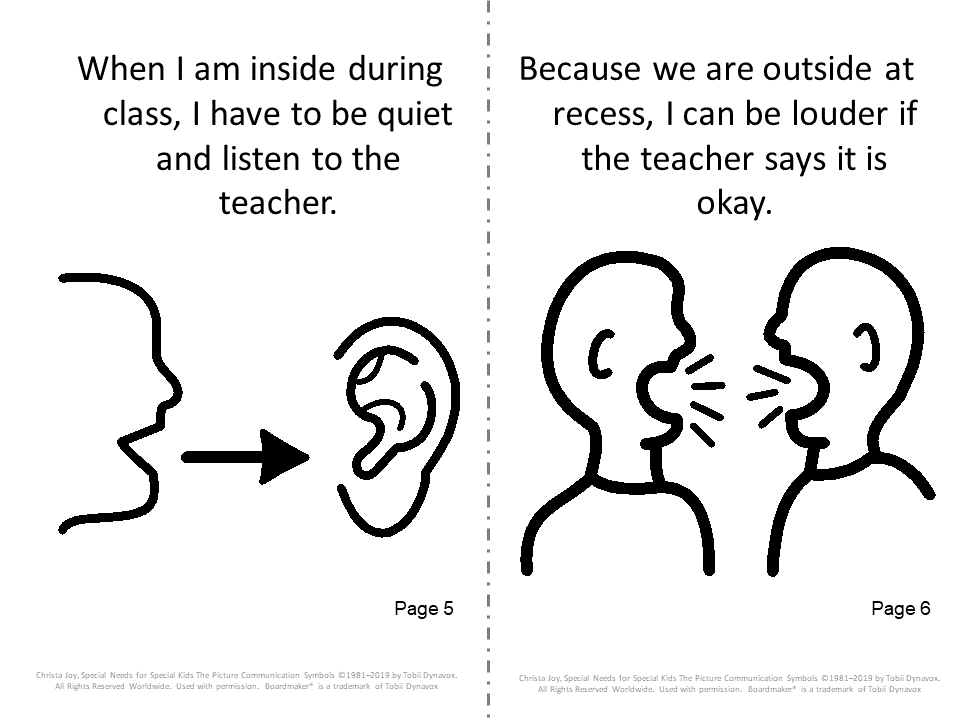
5. Additional activities to support your social story for recess
Finally, adding some cut and paste or circling activities is a good way for you to assess if students understand the information when presented in a quiet, low distraction environment.

I created the Venn Diagram below just for this blog post. It compares and contrasts student behaviors on the playground vs the classroom. It you would like a FREE copy of this activity, just click the button below.
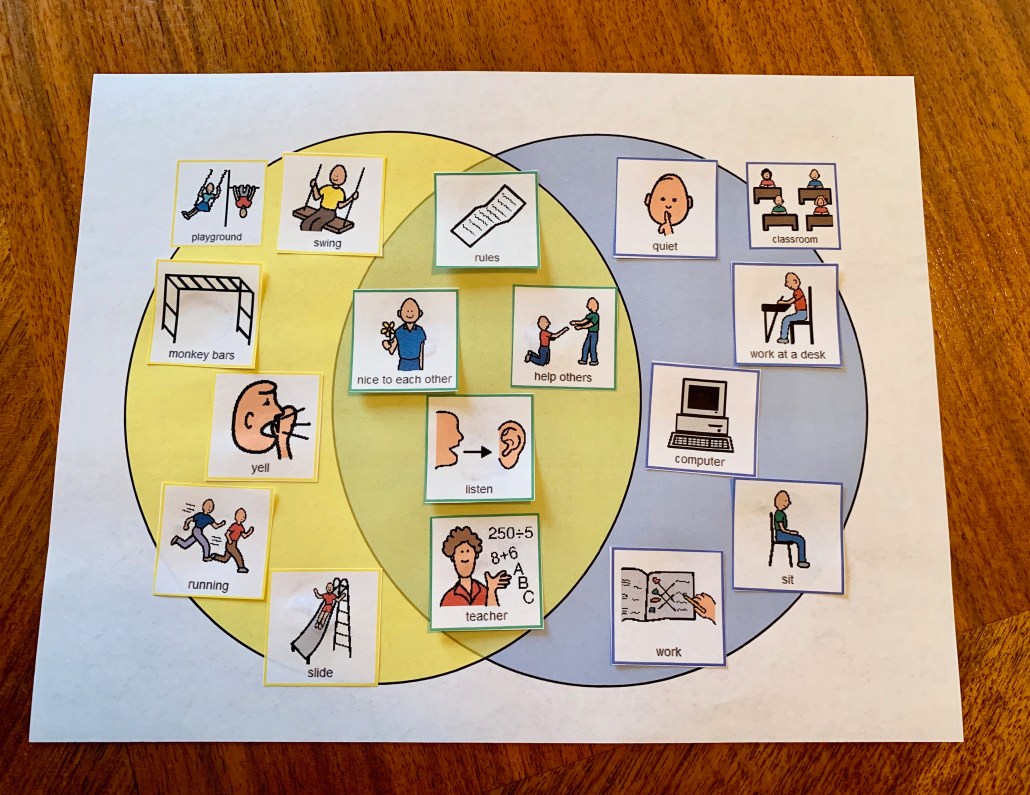
6. Identify a safe place
I learned this one the hard way, and hope to help you learn from my mistakes. Sometimes our students know what they are supposed to do. They do their absolute best. But, there are times they simply get too overwhelmed or over-stimulated. It is a great idea to identify a safe place students can go when feeling overwhelmed and need a break. You can even put this in your social story for recess. It could be a tree, a bench, or maybe you even take an object like a safety cone with you to recess. Place the cone in a location other students will not bother it, but is consistent and easy to access for your students. Explain to your kids, that if they need help or just need a break, then go to the safe place and a teacher will come to help them. This fosters independence and learning the valuable skill of asking for help.
So, there you go!! Recess in 5 not-so-easy steps. But boy is it worth it.
- Be intentional and get some background information
- Practice, practice, practice
- Use visual cues
- Using a social story for recess
- Additional activities
- Identify a safe place
If, after all of this work, Joey still is sifting wood chips through his fingers or Sally is spinning the swing in circles, at least you know that is their CHOICE and not because he/she has no idea what to do at recess.
Grab my complete social story unit for recess.
